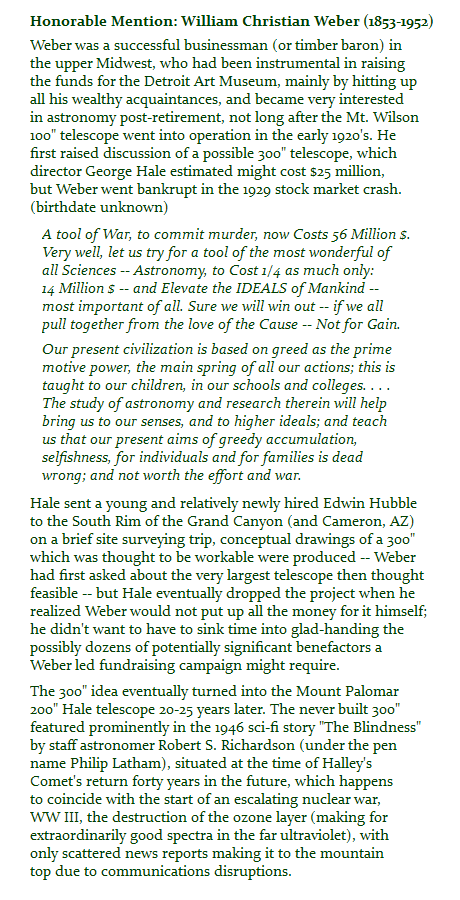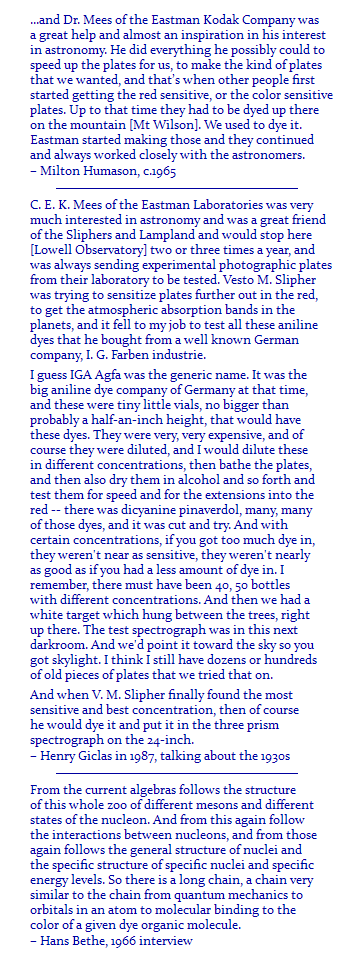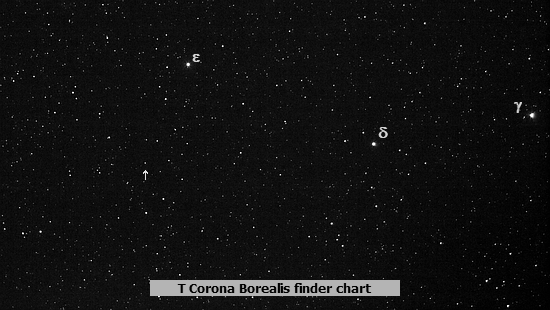
This Month in the History of Astronomy - May

- May 6, 1872 - Willem de Sitter, Dutch astronomer and
mathematician, who worked at the Cape Observatory in South Africa
and later became chair of astronomy at Leiden University for the
last fifteen years of his life.
He's chiefly remembered now for the de Sitter model of the universe
(1917), an early solution to Einstein's equations of general
relativity which is spatially flat, has no matter in it (zero
density), but a positive cosmological constant, so it expands.
Two years before his death he co-authored a paper with Einstein,
creating what's called the Einstein-de Sitter universe (1932), in
an attempt to combine all the observational data then known into
a coherent model for the universe; this universe is also flat, but
contained matter and therefore decelerated.
During WW I, de Sitter provided the only copies of Einstein's papers
on his new theory of relativity (general relativity) to the English
speaking world, via Arthur Eddington in Great Britain, who would be
instrumental in promoting and testing the theory at the May 29, 1919,
total solar eclipse (see below).
- May 8, 1906 - Nicholas Mayall, American astronomer known
primarily for his extra-galactic work, though he also worked on
Pluto's orbit and the Crab Nebula supernova remnant. He spent 28
years at the Lick Observatory (1932-60) before becoming the
second director of Kitt Peak Nat'l Observatory (1960-71) until
his retirement, where he oversaw the planning and construction
of the 4-meter telescope which now bears his name; he had previously
played a significant role in bringing Lick's 120-inch telescope to
completion.
Mayall had an unusual educational and early career path: after
completing his undergraduate degree and first year of graduate
school at the University of California, Berkeley, he became a
research assistant at the Mount Wilson Observatory (1929-31),
where he worked with Edwin Hubble, Milton Humason, Seth Nicholson,
and others of the period, during a time when people like Einstein
and James Jeans came to Pasadena for extended visits. He then
returned north and did his Ph.D. on galaxy counts, formally at
UC/Berkeley, while being at the Lick Observatory, even though
the work was both suggested and overseen by Edwin Hubble. After
his Ph.D. (1934) Mount Wilson was unable to take him back on
their staff due to the Depression (though they wanted to), and
he was only barely able to stay at the Lick Observatory -- on an
assistant janitor's salary for his first two years, before Robert
Trumpler left Lick to take a faculty position at UC/Berkeley;
this freed up a full time staff astronomer's salary, which Mayall
split with A. B. Wyse, another young Ph.D.
I was only a graduate student and I was taking
these two years off to get some practical observatory experience,
so I was way down on the totem pole, just a computer assistant
there. But I regard those two years as the most influential ones
in my whole career. I learned so many new things and met so many
fine men; it really opened my eyes to what was going on in
astronomy.
- Nick Mayall in 1977, speaking of his time at Mount Wilson.
- May 15, 1713 - Nicholas Louis de la Caille (or de Lacaille),
French astronomer and mapmaker who demonstrated that the Earth bulged
at the equator. From 1751 to 1753 he mapped the southern skies from
The Cape of Good Hope and established the 14 "modern" constellations
there.
- May 17, 1835 - J. Norman Lockyer, discoverer of the element
helium in 1868, while making visual spectroscopic studies of the sun
(helios), when he attributed unknown absorption lines to the new
element, not located on earth until 1891. It's the second simplest
and most abundant element in the universe after hydrogen -- though
rare on earth because here it results from the alpha decay of
radioactive elements.
Sir Lockyer is also known as the Father of Archeoastronomy: he was
among the first to propose that Stonehenge was an astronomical
observatory and that the Egyptian pyramids and great medieval
Christian cathedrals were built along important astronomical
orientations.
- May 20, 1929 - Sidney van den Bergh, Dutch-born Canadian
astronomer who spent the first half of his career at the David
Dunlap Observatory (DDO) of the University of Toronto (1958-77)
before moving to the Dominion Astrophysical Observatory (DAO -
Victoria, British Colombia). He worked across many fields of
astronomy, but primarily on the Milky Way, nebulae, star clusters,
variable stars, supernovae, and galaxies. He was director of DAO
from 1978-86, was president of the Canadian Astronomical Society,
and vice-president of the International Astronomical Union for a
decade (1972-82). In 1990 he received the Henry Norris Russell
Award of the American Astronomical Society.
- May 22, 1920 - Tommy Gold, iconoclastic and outspoken
Austrian-born British cosmologist who never got a Ph.D.
Besides his work with Fred Hoyle and Hermann Bondi on the steady
state theory, Gold, after moving to the U.S. at age 36, is probably
most famous now for raising the alarming possibility that the first
lunar lander might sink into a deep, quicksand-like layer of fine
lunar dust and immediately be lost.
In 1959 he switched from Harvard to Cornell, and subsequently
hired both Carl Sagan (who'd been denied tenure at Harvard) and
Frank Drake, as well as being instrumental in the building of the
Arecibo radio telescope.
Later he would propose what's known as the deep hot biosphere,
anaerobic bacteria and other similarly simple lifeforms living
deep down in the earth's crust in a hitherto unknown ecosystem;
when a Swedish drilling team stopped after going a couple of
kilometers down without finding anything his quip was that they
didn't go deep enough.
- May 25, 1865 - Pieter Zeeman, Dutch physicist who discovered
the splitting of spectral lines by strong magnetic fields, an effect
now named after him, though it was first predicted by his mentor Hendrik
Lorentz, with whom he shared the 1902 Nobel Prize in Physics, only the
second time it had ever been awarded. George Hale observed the Zeeman
effect in sunspots in 1908, leading to the recognition that they are
dark because magnetic fields are acting to impede motion of hot material
into these regions, "bottling up" gas which cools by radiating away
some of its initial heat content. Zeeman also helped discover the
isotope of argon with mass number 38.

- May 26, 1882 - Kenneth Mees (often C.E. Kenneth Mees,
for Charles Edward), pioneering British photographic scientist who
developed the first emulsions for astronomical use, as well as some
of the first sensitizers making films respond to infrared light out
to ~13,000Å (1933).
After getting his doctorate in photographic theory at the
University of London (1906) working under Chemistry Nobel Laureate
William Ramsay, Mees
went to work for Wratten and Wainwright, Ltd., assisting Frederick
Wratten in developing some of the first panchromatic (red sensitive)
photographic plates. In 1912, Eastman Kodak bought Wratten &
Wainwright chiefly because George Eastman wanted to acquire Kenneth
Mees, bringing him to Rochester, NY, creating the Kodak Research
Laboratories, and making him its first director. Later he would
be VP in charge of Research and Development for Kodak until his
retirement in 1955.
Mees ran the first ever school for aerial photography, during
World War I. Eventually elected to the National Academy of
Sciences (1950 - after he finally became a US citizen), Mees
authored over 100 scientific papers and oversaw the development
of such famous color films as Kodachrome (1935, after non-wandering
dyes were discovered), Ektachrome (1940, using "color couplers"
which form the dyes from developer reaction products), and
Kodacolor (1942).
His continued and dedicated support of ever better photographic
emulsions for astronomical use was vital for much of astronomy
until the switch-over to solid state, electronic detectors some
decades after his death in 1960. One of the key insights Mees
helped foster was the realization that speed was not necessarily
the central issue for astronomical applications so much as
minimizing what's called reciprocity failure -- the tendency
for emulsions to behave like leaking buckets when the light
levels are very low and the exposures very long. That, as well
as the fact that slower, fine-grained emulsions might out-perform
in detecting the faintest objects since film grain acts as a
limiting noise source.
- May 28, 1930 - Frank Drake, American radio astronomer
and SETI (Search for ExtraTerrestrial
Intelligence) pioneer, who developed the famed equation
named after him -- sometimes said to be the second most famous
equation in the world, after E=mc2 -- shortly after
the completion of Project Ozma (1960), the first search (of two
stars: τ Ceti and ε Eridani) for artificially generated
radio signals.
Drake's early work at the National Radio Astronomical Observatory
(NRAO) was mainly on the solar system, where he discovered the
ionosphere and magnetosphere of Jupiter, but he also made early
maps of the galactic center.
He was instrumental during this time in getting Arecibo upgraded
from a facility for upper ionospheric research into one suitable
for general purpose radio astronomy. He would serve as director
there from 1966 to 1968, followed by a decade as director of the
National Astronomy and Ionosphere Center (which includes Arecibo)
after it was created in 1971.
Drake was president of the board of trustees of the SETI Institute
when it was founded in 1984, was President of the Astronomical
Society of the Pacific from 1988 to 1990, and was chairman of the
Board of Physics and Astronomy for the National Research Council
from 1989 to 1992. He was elected to the National Academy of
Sciences in 1972.
- May 31, 1912 - Martin Schwarzschild, German-born American
astrophysicist. The son of also famous astrophysicist Karl
Schwarzschild (see Oct 9), Martin
left Germany in 1936 and spent most of his post-WW II career at
Princeton working in a multitude of areas relating to stellar
structure and stellar evolution. His 1958 book on the subject
was the standard text for the next 20+ years. After retirement
he also contributed to the field of galaxy dynamics, building
theoretical models of triaxial galaxies.
Discoveries and other firsts

©2002-2024, Chris Wetherill. All rights reserved. Display here does
NOT constitute or imply permission to copy, republish, or redistribute
my work in any manner for any purpose without prior written permission.

[ Back to April ||
On to June ]
[ To: History Directory ||
Main VISNS page ]





